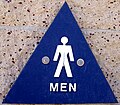نماد جنسیت: تفاوت میان نسخهها
Poorya0014 (بحث | مشارکتها) |
(بدون تفاوت)
|
نسخهٔ ۲۵ مارس ۲۰۱۶، ساعت ۰۹:۵۲
این مقاله هماکنون برای مدتی کوتاه تحت ویرایش عمده است. این برچسب بهمنظور جلوگیری از تعارض ویرایشی اینجا گذاشته شدهاست. لطفاً تا زمانی که این پیام در اینجا نمایش داده میشود، ویرایشی در این صفحه انجام ندهید. این صفحه آخرین بار در ۲۵ مارس ۲۰۱۶، ساعت ۰۹:۵۲ (ساعت هماهنگ جهانی) (۸ سال پیش) ویرایش شده است – این زمان تخمینی موجود در میانگر است؛ . اگر این صفحه در چند ساعت اخیر ویرایش نشده است، لطفاً این الگو را حذف کنید. اگر خودتان این الگو را به صفحه اضافه کردهاید، لطفاً در میانهٔ بازههای مختلف ویرایشی آن را حذف کنید یا با {{در دست ساخت}} جایگزین کنید. |
نماد جنسیت نمایانگر جنسیت یک جاندار است.
نمادهای استاندارد
دو نماد جنسی نر ♂ و ماده ♀ از نشانههای ستارهشناسی گرفته شدهاند که نمادهایی هستند از سیارههای کلاسیک مریخ و ناهید که از زمان رنسانس تا کنون مورد استفاده هستند.[۱] این دو نماد همچنین به دو عنصر آهن و مس نیز اشاره می کنند.
They were first used to denote the effective sex of plants (i.e. sex of individual in a given crossbreed, since most plants are هرمافرودیت) by کارل لینه in 1751.[۲] They are still used in scientific publications to indicate the sex of an individual, for example of a patient.[۳] Pedigree charts published in scientific papers now more commonly use a square for male and a circle for female.[۴]
The shape of the Mars symbol has been likened to an iron-tipped spear (i.e. a weapon mainly used by men) and shape of the Venus symbol to a bronze mirror or a دشکی (stereotypically associated with women in former centuries).[نیازمند منبع]

|
نماد مارس (U+2642 ♂). نماد جاندار نر یا مرد. |

|
نماد ونوس (U+2640 ♀). نماد جاندار ماده یا زن. |

|
مربع symbol (U+25A1 □). نماد مرد در خانواده در جدول پدیگری.[۴] |

|
دایره symbol (U+25CB ○). نماد زن در خانواده در جدول پدیگری.[۴] |
نمادهای دگرباشان
برای تأییدپذیری کامل این مقاله به منابع بیشتری نیاز است. (October 2010) |
Numerous variations of gender symbols have been developed in the context of دگرباشی جنسی (lesbian, gay, bisexual and transgender) culture since the 1970s.[۵] Some of these symbols have been adopted into یونیکد beginning with version 4.1 (2005).

|
From the symbol of تیر (سیاره) (U+263F ☿). This symbol is used to indicate a virgin female (for example, in genetic analysis). Also used in botany to indicate flower with both male and female reproductive organs. Mercury is one traditional symbol used by intersex people; a usage that derives from هرمافرودیته of Greek mythology.[۵] |

|
From the female and male symbols (U+26A5 ⚥). بیناجنس[نیازمند منبع] or تراجنسیتی.[۵] |

|
Another transgender symbol, a combination of the male and female sign with a third, combined arm representing non-binary transgender people (Unicode: U+26A7 ⚧). |
Other gender symbols in یونیکد and table 4.1+:

|
⚢ (U+26A2): Double female sign, often used to symbolize lesbianism.[۵] |
| ⚣ (U+26A3): Double male sign, used since the 1970s to represent gay men.[۵] | |

|
⚤ (U+26A4): Interlocked male and female sign, used since the 1970s to represent gay liberation.[۵] Today it might also be used by a دگرجنسگرایی who is aware of the diversity between men and women |

|
⚦ (U+26A6): Male with stroke sign, used as a symbol for transgender. |

|
⚨ (U+26A8): Vertical male with stroke sign. It means ‘other’ gender. |

|
⚩ (U+26A9): Horizontal male with stroke sign. It also means ‘other’ gender. |

|
⚪ (U+26AA): Medium white circle base, used as a symbol for بیجنسگرایی, بیجنسگرایی or جنسیت کوییر (neuter). |

|
⚲ (U+26B2): Neuter. This is in fact the shape of the original (medieval) "Venus" symbol (depicting a hand mirror), the additional horizontal bar being of modern date. [نیازمند منبع] |
نمادهای توالتهای عمومی
-
مردانه و زنانه
-
زنانه
-
مردانه
منابع
- ↑ continuing medieval (11th century) symbols known from امپراتوری روم شرقی manuscripts, possibly with precedents in horoscopic papyri of دوران باستان متأخر (late 4th century)[citation needed].
- ↑ Stearn, William T. (May 1962). "The Origin of the Male and Female Symbols of Biology". Taxon. 11 (4): 109–113. doi:10.2307/1217734.
- ↑ Zhigang, Zhigang; et al. (25 September 2009). "A HIV-1 heterosexual transmission chain in Guangzhou, China: a molecular epidemiological study". Virology Journal. BioMed Central. 6 (148): Figure 1. doi:10.1186/1743-422X-6-148. Retrieved 31 December 2015.
(Mars male gender symbol) indicates male; (female Venus gender symbol) indicates female
- ↑ ۴٫۰ ۴٫۱ ۴٫۲ Schott, G D (24 Dec 2005). "Sex symbols ancient and modern: their origins and iconography on the pedigree". BMJ. British Medical Journal. 331 (7531): 1509–1510. doi:10.1136/bmj.331.7531.1509. Retrieved 31 December 2015.
- ↑ ۵٫۰ ۵٫۱ ۵٫۲ ۵٫۳ ۵٫۴ ۵٫۵ "Symbolism". LGBTQA+ WebCenter. Eastern Illinois University. Retrieved 31 December 2015.
پیوند به بیرون
| در ویکیانبار پروندههایی دربارهٔ نماد جنسیت موجود است. |



